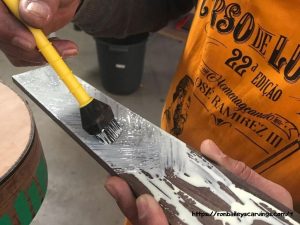How to glue wood?
Every woodworker sometimes makes mistakes. Whether you want to fix those mistakes, or you need to glue pieces of wood together in a larger project, you need to have wood glue handy to do the work. With the best wood glue at hand, the process is simple – all you need to do is to align the pieces together at the right angle and let the glue dry slowly. Apply thin layers of glue on each side, and wait for about 30 minutes up to an hour until it dries enough.
The choice of glue for a particular type of wood
Most wood glues are effective with softwood, and the connection they make is even stronger than the wood itself. However, the best wood glue is the one that also works with hardwood. In practice, general use glues will perform extraordinarily on hardwood, but the trick is that they are sometimes too stiff to sand, and then you end up having visible joints.
Wood treatment before applying glue
Before you even think of applying wood glue to your work, make sure that you have polished the surfaces correctly. You should sand the wood to even the surface and get rid of all the potential lumps. After you are done sanding, take a brush or a blowdryer to remove the sand dust entirely. If there are fibers sticking out of the surface after sanding, because of the nature of the wood, I recommend you make a wood filler that will help you cover it up once the joint is made.
How to store wood glue
Wood glue should be stored at room temperature. This means you can keep it in your storage space, as long as it’s not too cold or too warm in there. Also, make sure to keep your glue at a safe distance from children and animals, like on a high shelf out of their reach.
How does weather affect wood glue?
Even the best wood glues (and even general type glue) aren’t fit to be used outdoors. In outside conditions, the glue dries too quickly and doesn’t hold the wood together very long. Some glues, like Titebond III Ultimate Wood Glue, for example, are designed to work on fresh air. On the other hand, high humidity and cold temperatures are also not desirable. So, before purchasing, figure out if you will only use the glue in your workshop or you need it outdoors as well.
My personal experience with wood glue

I love super strong wood glue, but the best woodworking glue in my experience doesn’t even have to be designed for wood. One of the brands that I find super-efficient is Gorilla -which is more general use glue, but far better than some of the best wood glues I’ve tried. When it comes to strong wood glue, my personal preference is Titebond II Premium Wood Glue, which is strong enough for my personal indoor projects.
FAQ on wood gluing
That really depends on the personal experience, but in my opinion, that would be Titebond II or Titebond III.
My personal choice for woodworking is Elmer’s Carpenter’s Wood Glue Max, but I only use it when I have large surfaces to glue together. I find it unpractical for details.
Depends. Some wood glues are resisting sanding very well – others not so much. I recommend you check the reviews of the users before deciding which one to get.
In theory – yes, but not many wood glues are fit for that task. Most of them are designed to be used indoors only.
Most wood glues are made to have a brown/golden color, which should help the joints fit in. However, you should still sand over the joints to make them unnoticeable.